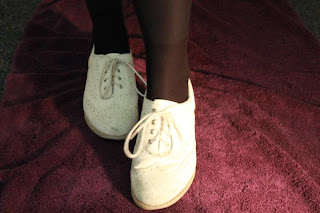Jessica Derges
Evaluation Digital Media Foundations
Our project ‘Happy Feet’ was developed and created over a
period of eight weeks. It combines the use of sound and visual techniques to
portray the development of dance, music, fashion and film over a time span of
eighty years.
When set the task of coming up with an original idea for the
project, there were many concepts we had in mind, however most of these were
unsuitable and difficult to produce, due to limited availability for space and
actors. We decided to go with our idea of Happy Feet after much consideration
about time span, space and unavailability of an actor. We also chose it because
it was challenging yet within our reach to produce.
We wanted to achieve a linear narrative structure throughout
the project, so we used techniques such as Mise-en-Scene to provide a link to
our through the ages narrative.
The costumes we chose were shoes and this proved to be more
difficult because there needed to be a considerable amount of difference from
one era to the next. However due to extensive research into costume from each
era, we were able to define from one decade to the next successfully. Different
styles of editing were used to create an advancement through time. Effectively,
this showed the process of film and television from the period of the 1920’s
through to 2000. Using Adobe Photoshop, I created a different edit for each
period in time, so that this narrative element would look effective and each
era was successfully defined.
The combination of visuals like the costume and the editing
allowed the audience to feel like they were following the narrative and also
allowed them to connect to the project. We were also able to productively allow
audiences to connect to the piece through the heavy use of stereotype. The
piece was structured in a narrative fashion as it showed a beginning, a middle,
an end and a change.
The use of a feet-only shot ignited a mystery to the
project. It enabled the viewer to raise questions relating to the project, as
there was no face or familiarity within the shots. This allowed the audience to
engage within the project more, therefore creating an enigmatic narrative. It followed Barthes' pattern of enigma by producing and raising questions about the film and draws the reader into following the piece.
The music was chosen to give familiarity to the audience,
which would effectively entise them into the project. It also opposed the other
areas of the project, by being obvious and well known. The audience would have
felt familiar with a lot of the music chosen, which allowed them to engage with
the project more. This is a way that our piece became interactive, as audiences could connect with the music and fashion of the film. We knew that whatever the age of the audience, there would be a section within the story that they could relate to, whether that be an era, fashion style or musical piece.
Our piece fitted well theoretically by using the linear and straightforward narrative style and the enigma code which allowed the piece to have a mysterious edge. I think it was successful in enticing and allowing the audience to interact with the piece, which was the main aim of this project.
Our piece fitted well theoretically by using the linear and straightforward narrative style and the enigma code which allowed the piece to have a mysterious edge. I think it was successful in enticing and allowing the audience to interact with the piece, which was the main aim of this project.































